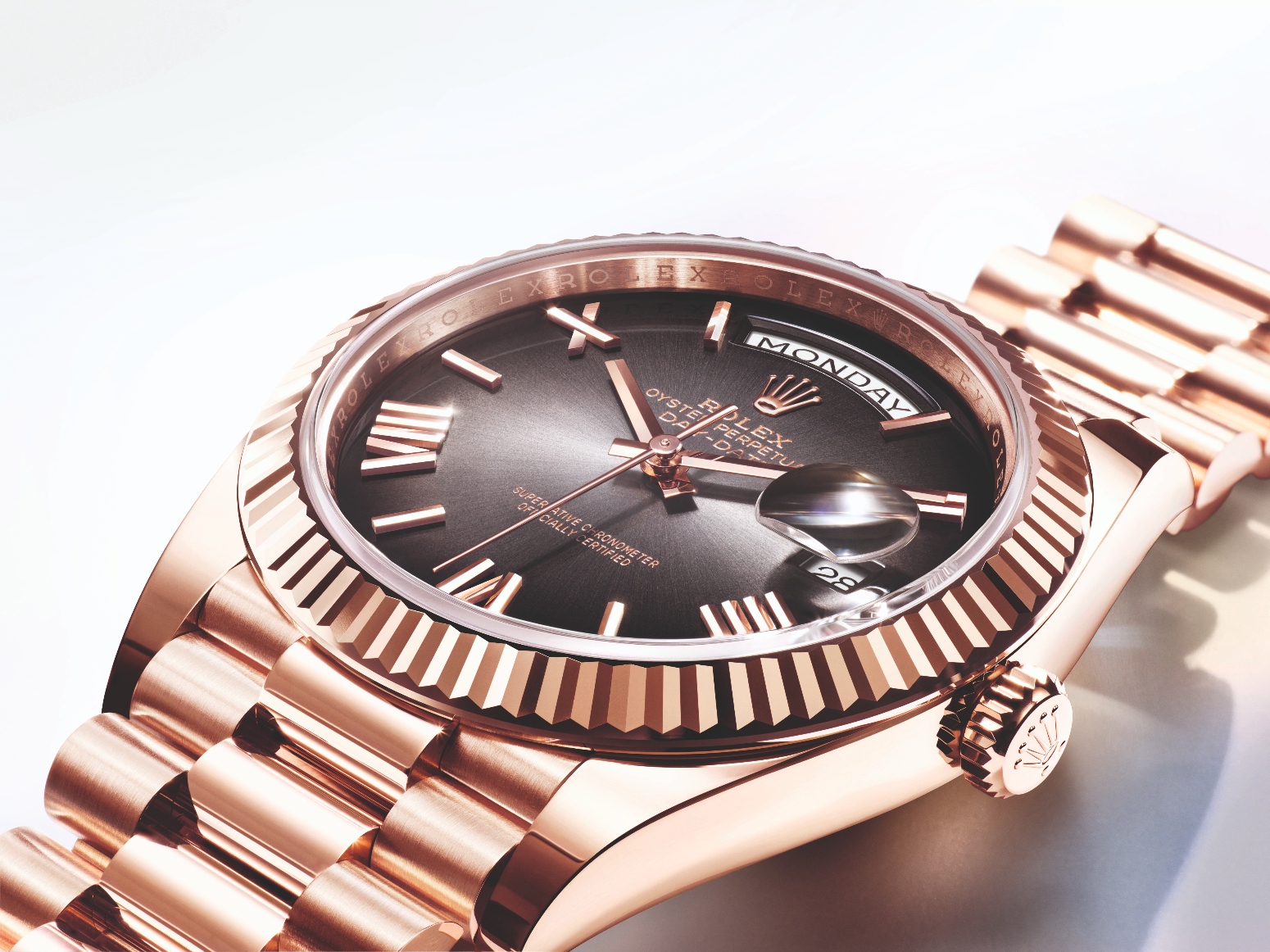 Rolex Oyster Perpetual Day-Date in Everose gold with President bracelet
Rolex Oyster Perpetual Day-Date in Everose gold with President bracelet
Everose Gold
These topics are intricate and deserve a brief exploration. We highlight this issue because luxury watchmaking has gained attention for its investment potential. In particular, certain watches may serve as alternative investment assets. While we’ve consistently warned against this notion, we recognize that many readers are intrigued by watches’ ability to not only maintain their value but potentially increase it.
Years ago, before we voiced our thoughts on the investment craze surrounding watches, we suggested this world could be quite unsettling. This notion was addressed in an Editor’s Note titled Watches as Currency, where watches crafted from precious metals epitomize this idea. If gold is viewed as a form of currency, owning a watch made from this material feels akin to having cash on one’s wrist. Perhaps it’s more like a digital display indicating the watch’s value. Some might argue this is just an invitation for thieves, yet in places like Singapore, wearing all-gold watches might feel exceedingly safe.
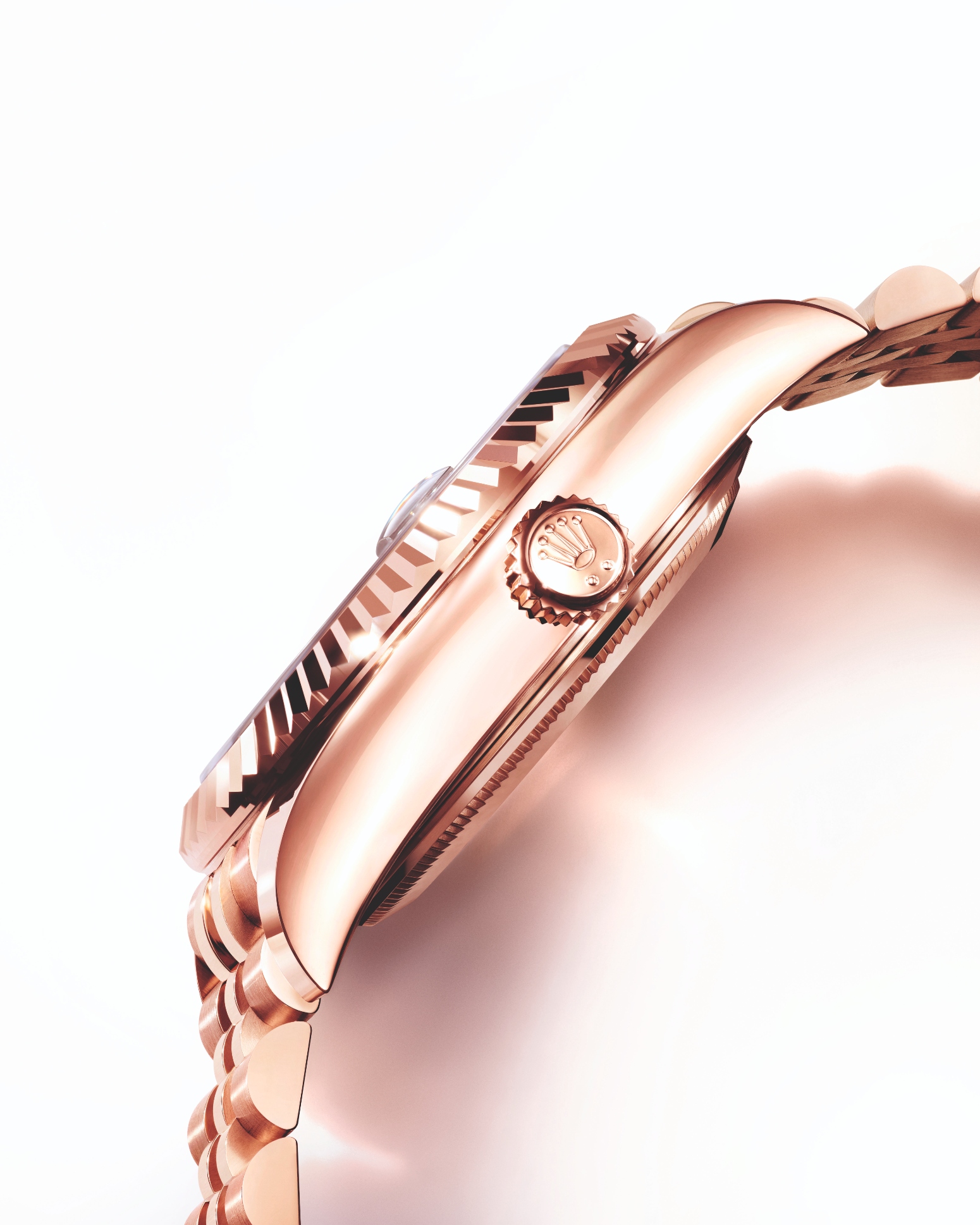 Rolex Oyster Perpetual Day-Date in Everose gold with President bracelet
Rolex Oyster Perpetual Day-Date in Everose gold with President bracelet
Conversely, the watch-collecting community is well aware that the top deals on the secondary market often involve watches made from precious metals. This includes any precious metal, not just gold. To be frank, these watches tend to depreciate the most, even those from illustrious Swiss brands. The reason for this phenomenon is complex, particularly when compared to inflated steel watches, but experts suggest that the retail prices for precious metals have typically been excessively high—especially when brands offer non-precious metal alternatives.
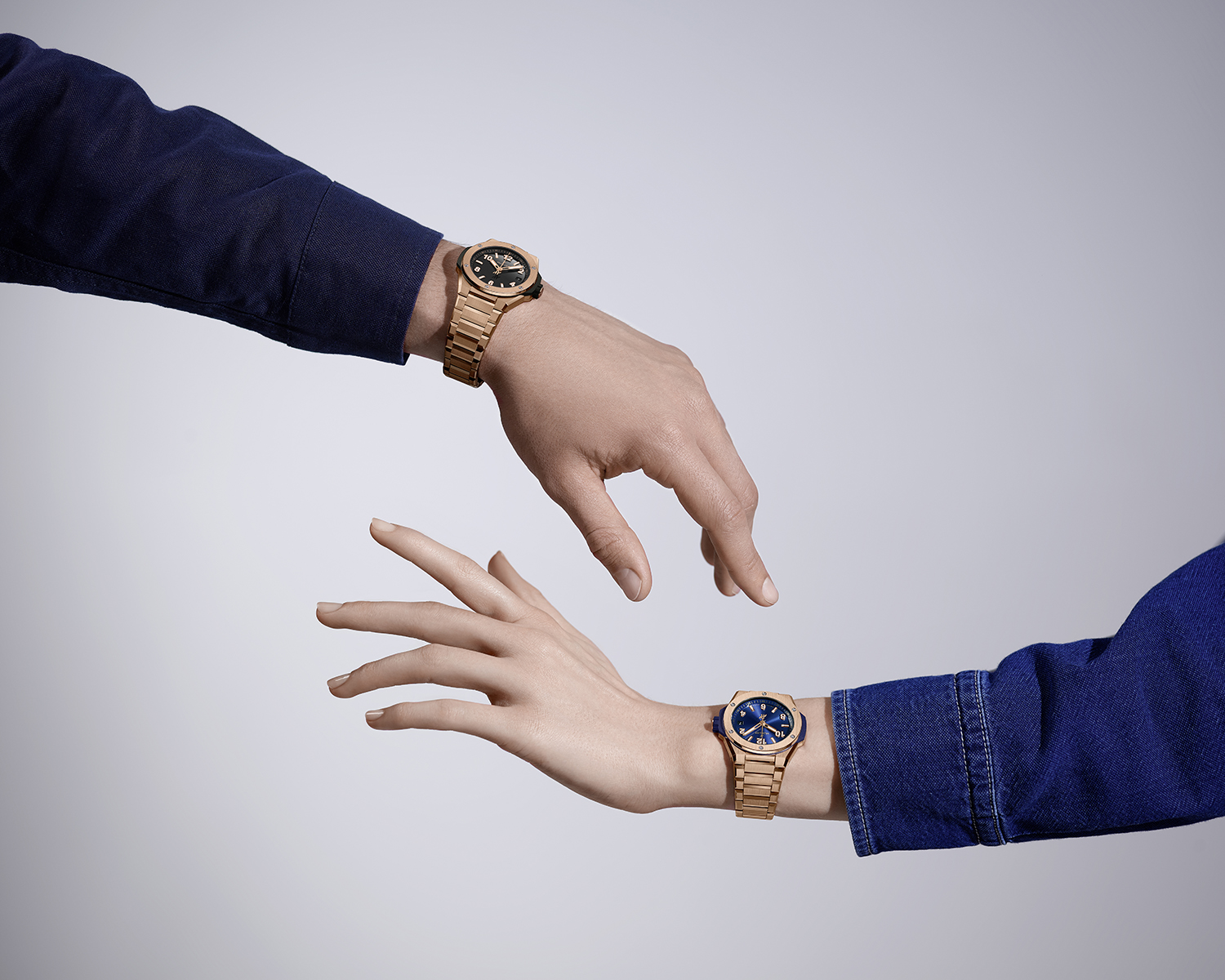 Hublot Big Bang Integrated Time Only King Gold
Hublot Big Bang Integrated Time Only King Gold
Magic Gold
In 2012, Hublot showcased the attributes of Magic Gold. While the brand had already established itself as innovative, its identity was largely linked to synthetic materials. Hublot also offers a proprietary gold alloy named King Gold, distinguished by a higher copper content giving it a unique reddish hue, yet this was eclipsed by the introduction of Magic Gold, a metal matrix composite (MMC) that we touched upon in summer. Hublot isn’t the only brand exploring MMCs, but we focus on Magic Gold due to its familiarity and ongoing role in their main collection—unlike Cerachrom and Ceragold.
Upon its release, Magic Gold was anticipated to revolutionize gold alloys by being scratch-resistant. It’s well-known that gold is soft and can scratch easily—steel, while harder, also bears its share of scratches, a common concern among collectors. Hublot aimed to create an 18k gold alloy that also offered impressive scratch resistance, a significant hurdle for any metal alloy. The manufacturer incorporated ceramic into a gold matrix to achieve this goal, marking an unprecedented approach in watchmaking, prompting collaboration with materials science experts at EPFL in Lausanne. Even though Hublot has its own R&D facility, significant foundational research relies on broader expertise.
The materials specialists began by choosing raw materials like 24k gold, aluminum, and boron carbide—the latter being a ceramic and one of the hardest substances known. The specific proportions are as follows: 75% gold, 3% aluminum, and 22% boron carbide. The boron carbide powder is compacted into a specific shape before being sintered to form a solid. Pure molten 24k gold is then injected into these pores at a pressure of 200 bars—Hublot has likened this process to forcing water into a room filled with footballs (EuropaStar, 2011). This creative analogy emphasizes that rather than the ceramic acting as the matrix containing gold, it’s vice versa. Thus, Magic Gold indeed constitutes an MMC. Consequently, it is harder and more scratch-resistant than conventional gold alloys, while preserving the luxurious aesthetic and properties of gold. Just how tough is it? Supposedly, only diamond tools can scratch Magic Gold.
Machining Magic Gold required the ordering of specialized CNC machines from Germany, equipped with ultrasonic cutters and diamond-tipped tools. Our previous report indicated that 28 bezels in Magic Gold took three weeks to machine, with a monthly output of only 30-40 complete cases. This unlikely has changed, as Magic Gold remains a rarity in the Hublot lineup. Importantly, this innovation continues 10 years after its debut, though no solution is flawless, and we may see updates to Magic Gold in the future.
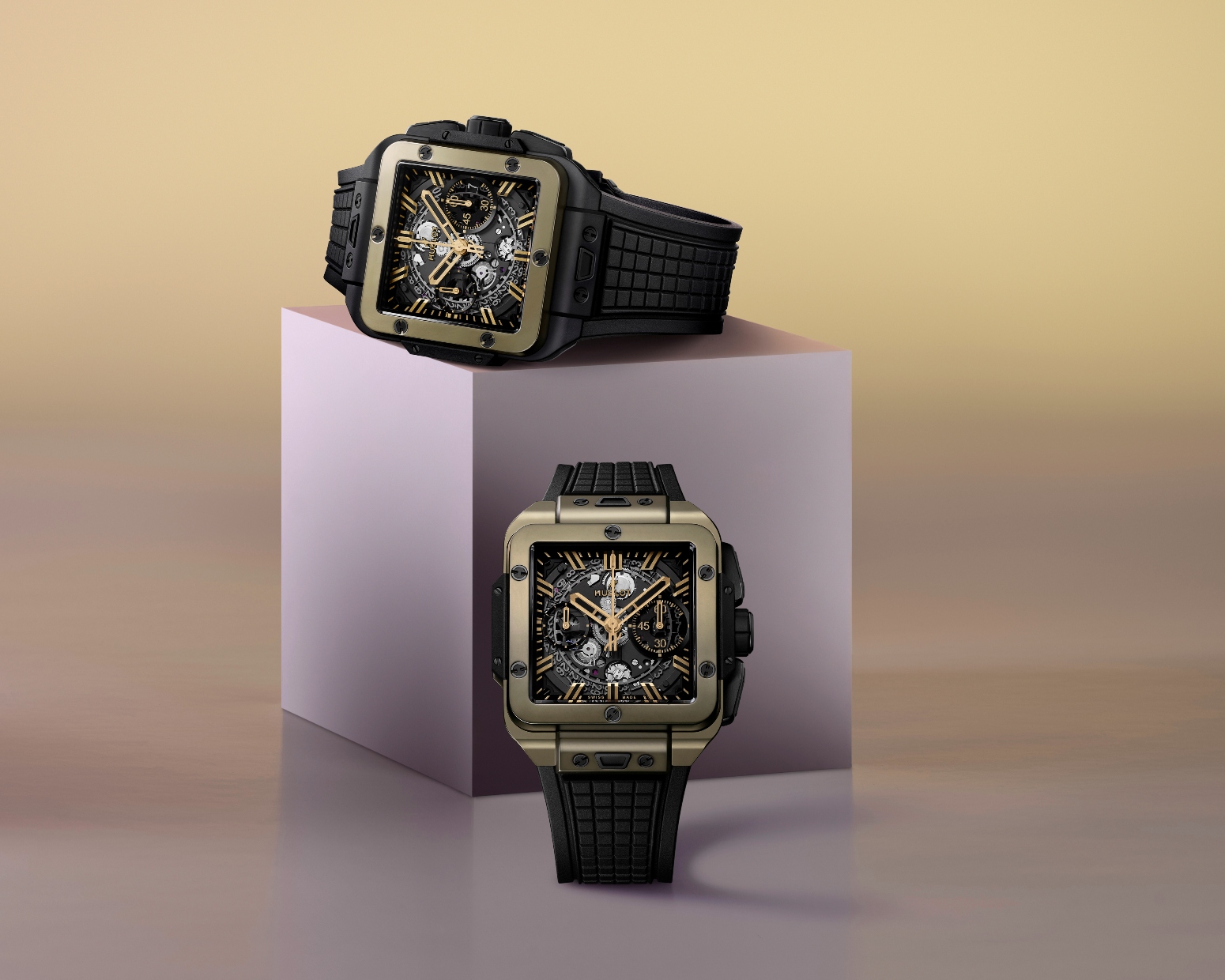 Hublot Square Bang Unico Ceramic Magic Gold
Hublot Square Bang Unico Ceramic Magic Gold
Sedna Gold
Transparent honesty is crucial regarding why larger watch brands often showcase their materials science expertise through clear advertising in their creations. Initially, Sedna gold was exclusively linked to Omega when it was unveiled in 2013, but it has since become part of Blancpain’s offerings too. Both brands are within the Swatch Group, and the availability of Sedna gold signifies synergies at play. While we recognize Omega’s advancements with precious metals, we also appreciate the strides made by Rado, Tissot, and Swatch in ceramics, composites, and various plastics.
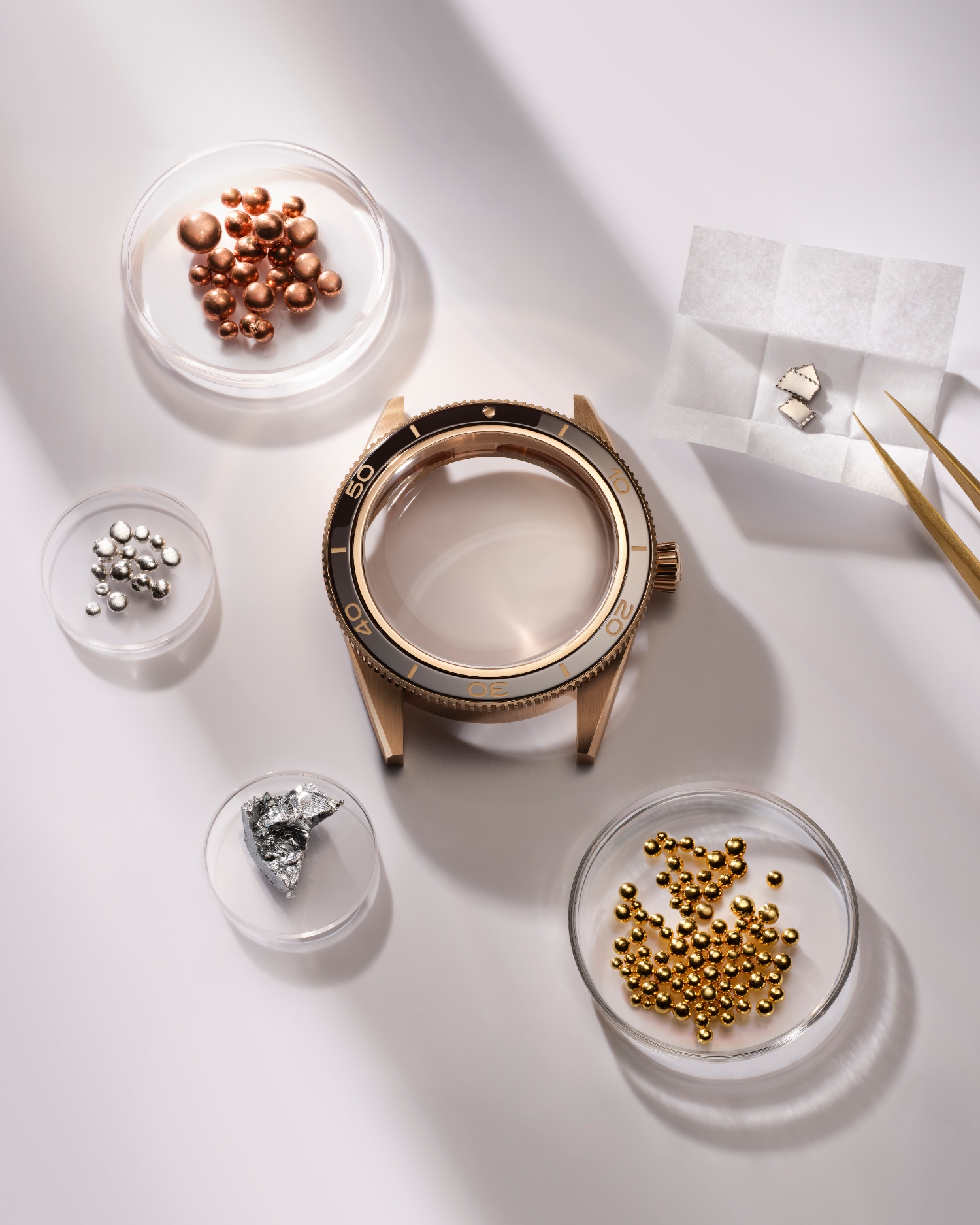 Omega’s depiction of Sedna gold’s component parts
Omega’s depiction of Sedna gold’s component parts
All of this demonstrates that the Swatch Group excels in fundamental research for new materials and their industrial application. While we previously reported in 2016 on Omega’s advancements with anti-magnetic movements, it’s worth noting that many Swatch Group brands have since adopted similar technologies. LiquidMetal, an amorphous alloy based on zirconium, was initially integrated into ceramic bezels by Omega but has also found its way to Blancpain’s products. Furthermore, Omega was the first to introduce Ceragold in 2012, a mix of ceramic and gold, though it lacks the robustness of Magic Gold.
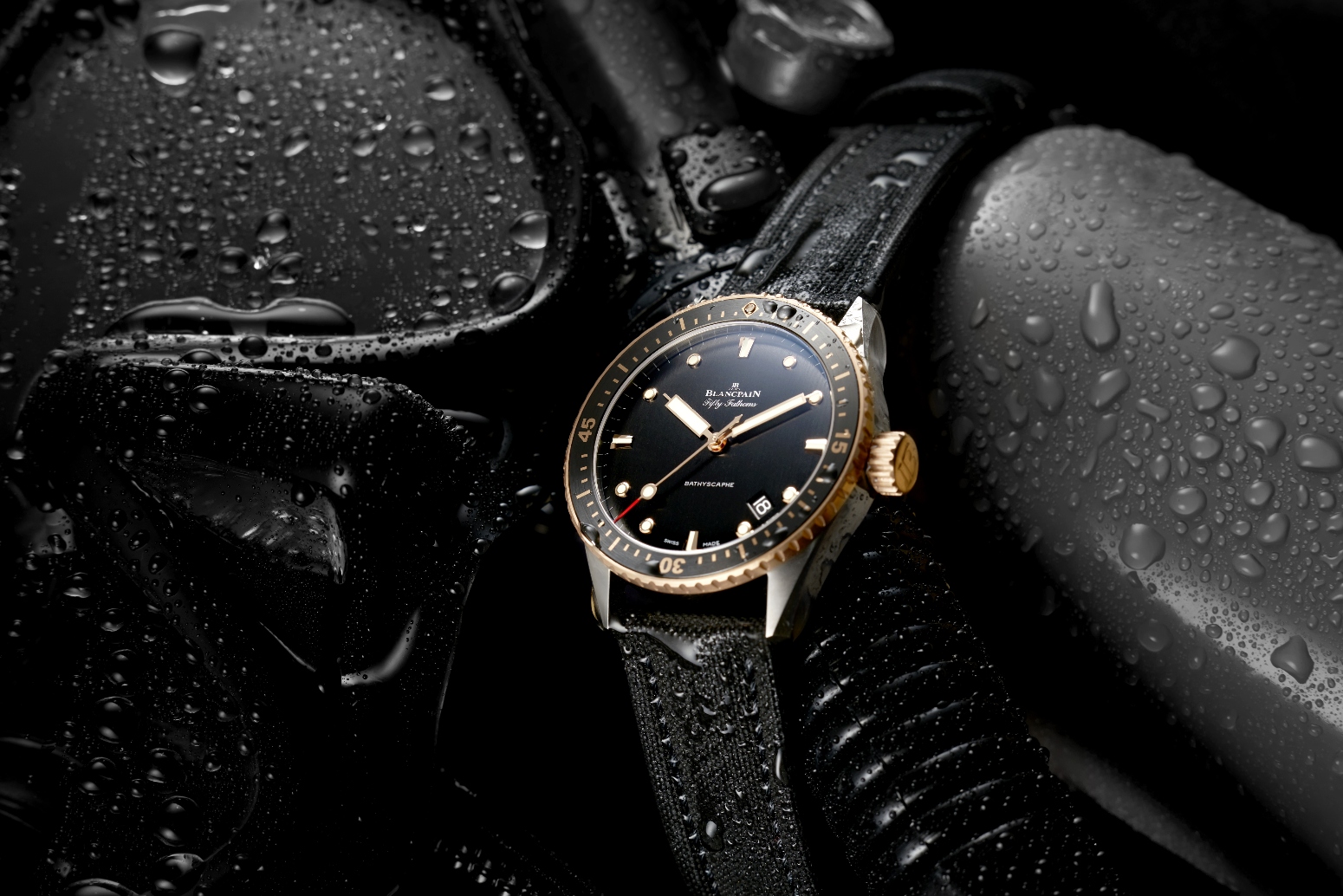 Blancpain Fifty Fathoms Bathyscaphe Cortina Watch 50th Anniversary
Blancpain Fifty Fathoms Bathyscaphe Cortina Watch 50th Anniversary
While Ceragold remains a niche material for Omega, Sedna gold is widely utilized. Named after a distant red planetoid, this 18k alloy is a proprietary blend of gold, copper, and palladium. Like other rose gold alloys, Sedna derives its unique hue from its copper content, with palladium ensuring color longevity, resembling the role of platinum in other alloys. Omega has aggressively employed Sedna gold, replacing traditional rose gold across collections, whereas Blancpain restricts its use mainly to the Fifty Fathoms Bathyscaphe line.
We would be remiss not to mention Omega’s recent endeavors in precious metal alloys, including Canopus gold and the widely recognized Moonshine gold. Swatch effectively managed key messaging, utilizing Moonshine gold in a version of the popular MoonSwatch. This is the most recognized brand-owned gold alloy due to Swatch’s extensive reach—the Mission to Moonshine model became one of the top Swatch designs of 2023 and consistently highlights that Moonshine is an Omega trademark.
 A. Lange & Söhne Datograph Perpetual Tourbillon Honeygold “Lumen”
A. Lange & Söhne Datograph Perpetual Tourbillon Honeygold “Lumen”
Honey Gold
Also featured in this updated list is the gold alloy introduced by A. Lange & Söhne in 2010. Initially appearing in the Homage to F.A. Lange limited trio, it is known as Honeygold, although we frequently refer to it as honey gold following our own style. The Glashütte manufacturer has been diligent in maintaining the limited use of honey gold. Five years after its impressive introduction, the company decided to present it again at Watches and Wonders 2015.
During this prelude to the grand Geneva show in Hong Kong, the 1815 200th Anniversary F.A. Lange was introduced as a limited edition of 200 pieces. Since then, honey gold has graced a few releases, not all connected to F.A. Lange. This year features the prominent Datograph Perpetual Tourbillon Honeygold Lumen model. Other significant models using this proprietary gold alloy include the last year’s Zeitwerk Minute Repeater and the standard Zeitwerk (2021), a second trio of Homage to F.A. Lange pieces (2020), and the Langematik Perpetual (2019).
Aesthetically, honey gold has a hue lying between rose and yellow gold, exhibiting a lower saturation—it’s paler yet redder than yellow gold and resembles honey closely. This color results from its higher copper percentage compared to standard yellow gold and the inclusion of zinc. Given it remains an 18k alloy, the remaining percentages account for the 25% of the alloy that is not gold.
A. Lange & Söhne did not develop honey gold solely for its appearance; this wasn’t the primary concern. Rather, the goal was to engineer a gold alloy that provided enhanced scratch resistance for watch cases. With a hardness of 320 Vickers, honey gold boasts roughly double the hardness of standard 18k yellow gold, which typically ranges from 150 to 160 Vickers. Thus, the outcome is a more durable watch case that resists dings and scratches effectively.
Even with its increased hardness, honey gold isn’t significantly more challenging to work with. Equipment designed to machine steel cases, which are even harder, can easily manage honey gold; it’s worth noting that A. Lange & Söhne does not produce cases directly. However, working with this material in movement components presents challenges for the finisseurs. The Homage to F.A. Lange watches feature balance cocks made of honey gold, unlike the usual German silver. Hand-engraving them with the brand’s floral motif becomes more demanding and time-consuming, necessitating a specialized set of burins with sturdier blades.
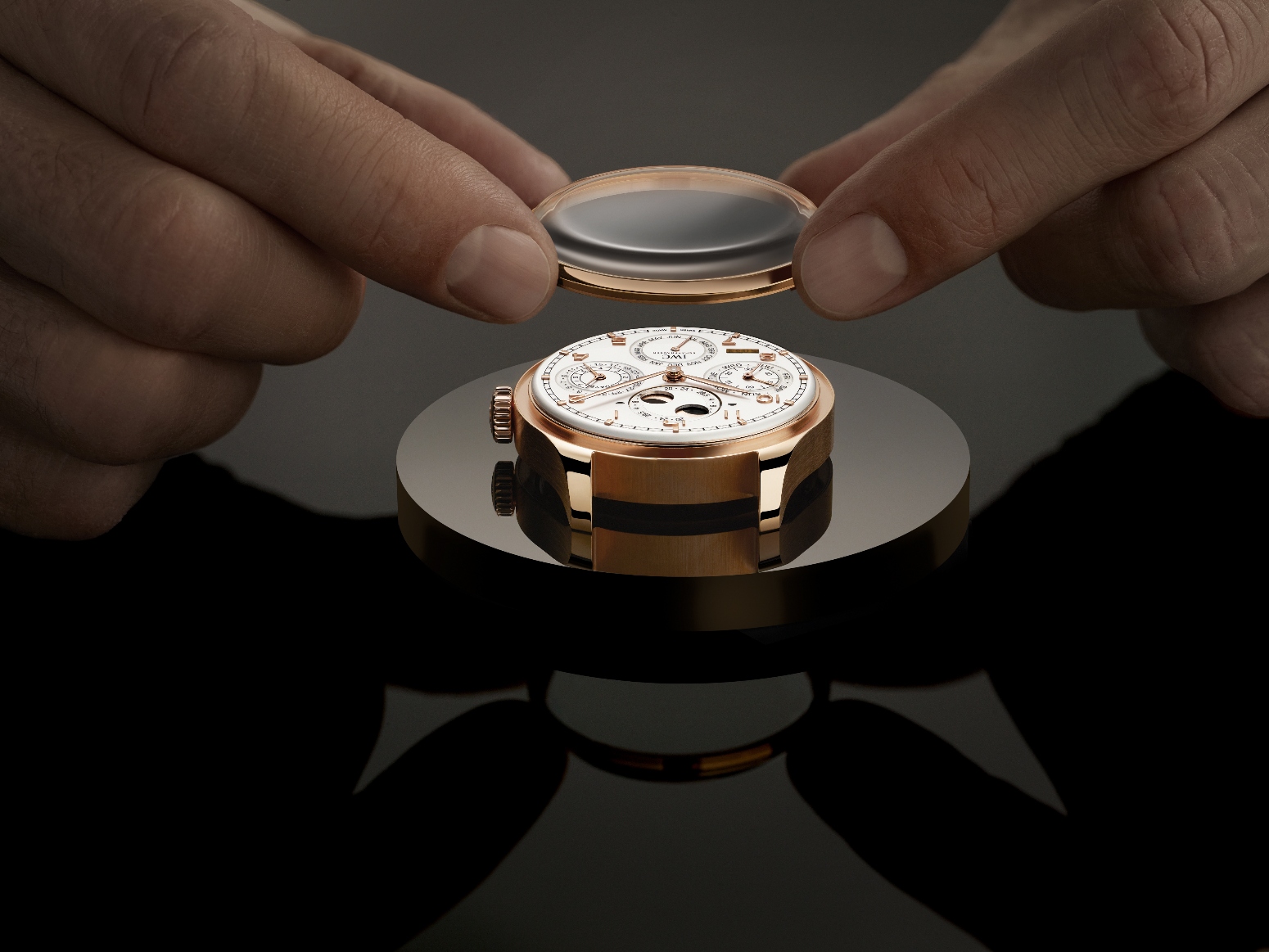 This page: IWC Portugieser Perpetual Calendar
This page: IWC Portugieser Perpetual Calendar
Armour Gold
Making its mark as a new proprietary gold alloy, Armour Gold is IWC’s first venture into precious metals—though it has a rich history of innovation. Known for its experiments with materials, including being the first top-tier brand to employ ceramic in cases, IWC maintains a reputation for offering strong yet visually appealing materials in its professional watch lines. Armour Gold continues to complement this tradition.
In discussions with IWC professionals in Geneva, the essence of Armour Gold was succinctly distilled. Its focus is on functional relevance alongside aesthetic appeal. Armour Gold certainly lives up to its name; all alloys listed here exhibit some form of functional uniqueness, although we did not conduct tests ourselves. IWC introduced this gold quietly in 2019, surprising many journalists who had expected it to be a new introduction for this year.
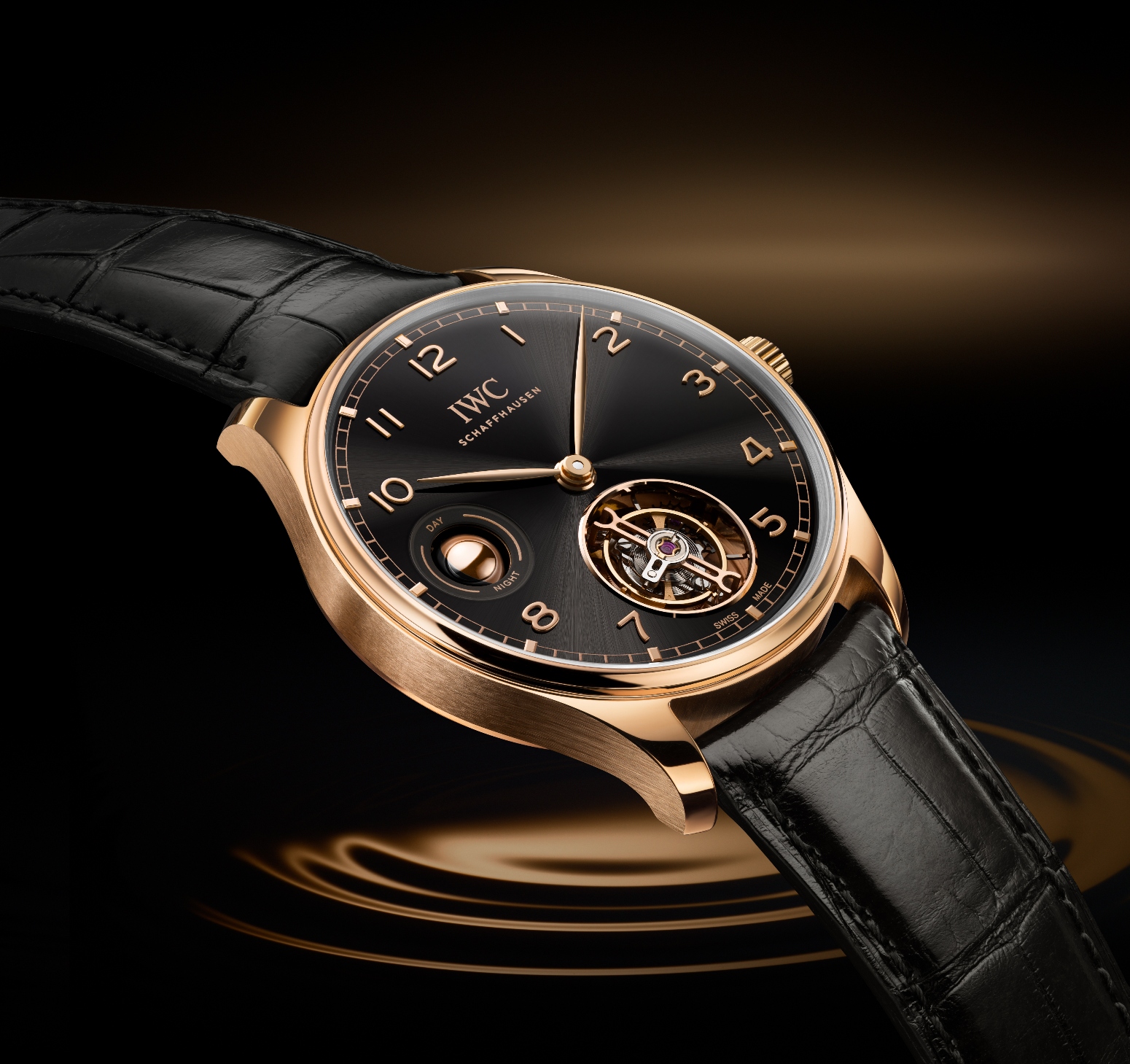 IWC Portugieser Hand-Wound Tourbillon Day & Night
IWC Portugieser Hand-Wound Tourbillon Day & Night
Mainly, the significant qualities that define Armour Gold are its wear resistance, with IWC ensuring it offers value beyond mere coloration. When launched with the Big Pilot’s Watch Constant-Force Tourbillon Edition Le Petit Prince, IWC declared it had introduced “hard gold” for the first time. This kind of gold is approximately five to ten times more durable against wear than standard red gold. By wear-resistant, we understand this to mean that it better withstands scratches compared to regular gold alloys. In a separate press release for a watch utilizing Armour Gold, the brand noted that it achieves such wear resistance and hardness through an “improved microstructure,” although specifics of this process remain unclear.
Currently, IWC offers nine models featuring Armour Gold, including three new introductions this year (Portugieser Perpetual Calendar 44 with black or white dial; and Portugieser Hand-Wound Tourbillon Day & Night).
This article first appeared in WOW’s Autumn Issue #74.
For more updates on luxury watch publications from WOW, click here.








